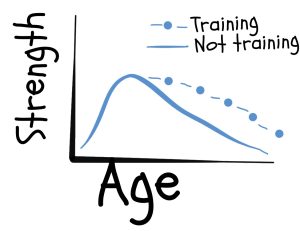I previously discussed considerations of using metformin, rapamycin, and NAD+ boosters to promote healthy aging, and the jury was mixed for all of them. But don’t despair, there is a bullet-proof way to improve aging health: exercise. Here we’ll look at muscle-strength training.
In terms of muscle physiology, aging is accompanied by an increase in catabolism and decreased capacity for anablism. That means, ever so surely, you will undergo muscle loss. Your muscle mass will peak around age 30, and by some estimates, at the age of 70 you will have roughly 30% of this capacity1,2.

Your goal therefore while aging is to maintain as much of the strength capacity that you already have as possible. Potentially achievable, with muscle-strength training. Compared to aerobic exercise, strength training activities have been less studied in regards to their influence on all cause mortality and age-related deaths. Recently though, a systematic review has combed through the literature to form a consensus view of how strength training benefits aging, and how much is actually needed to be beneficial3.
The meta analysis looked at studies from 16 independent cohorts, ranging in size from 3,809 to 479,856 participants, including both men and women, and age ranges from 18-97 years. Consistent trends were noted across studies. Namely, muscle strengthening activities were associated with a 15% lower risk of all-cause mortality. A clear J-shaped reduced mortality risk was observed though, meaning more muscle strength training was not necessarily better. Optimum training was at 30-60 min/week while going higher, up to 140 min/week, removed the mortality-protecting effects, for reasons that remain unclear. What was clear though was muscle strength training provided a 17% reduced risk of cardiovascular disease (optimum 60 min/week), 12% reduced risk of total cancer (optimum 30 min/week), and 17% lower risk of diabetes (optimum 60 min/week)3.
Remarkably, combining strength training with aerobic exercise could provide up to 40% reduction of all-cause mortality risk3.
The bottom line: the aerobic/strength training combo is pretty much the best healthy aging intervention available. Not only that, it will have the lowest chances of side-effects, with the highest chance of you being a ‘responder’. So, what are you waiting for? Stop reading blogs on how to intervene in aging, and just start intervening, with exercise!
Going Deeper…
1.
Zouhal H, Jayavel A, Parasuraman K, Hayes LD, Tourny C, Rhibi F, Laher I, Abderrahman AB, Hackney AC. Effects of Exercise Training on Anabolic and Catabolic Hormones with Advanced Age: A Systematic Review. Sports Med. 2022 Jun;52(6):1353-1368. doi: 10.1007/s40279-021-01612-9. Epub 2021 Dec 22. PMID: 34936049; PMCID: PMC9124654.
2.
Korhonen MT, Cristea A, Alén M, Häkkinen K, Sipilä S, Mero A, Viitasalo JT, Larsson L, Suominen H. Aging, muscle fiber type, and contractile function in sprint-trained athletes. J Appl Physiol (1985). 2006 Sep;101(3):906-17. doi: 10.1152/japplphysiol.00299.2006. Epub 2006 May 11. PMID: 16690791.
3.
Momma H, Kawakami R, Honda T, Sawada SS. Muscle-strengthening activities are associated with lower risk and mortality in major non-communicable diseases: a systematic review and meta-analysis of cohort studies. Br J Sports Med. 2022 Jul;56(13):755-763. doi: 10.1136/bjsports-2021-105061. Epub 2022 Feb 28. PMID: 35228201; PMCID: PMC9209691.
